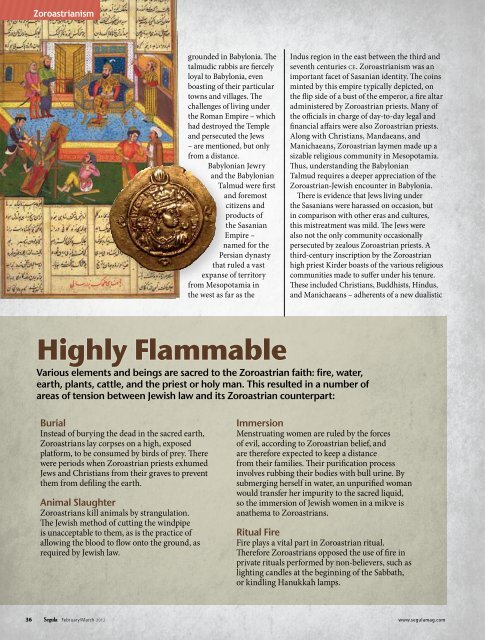In the Persian Empire of the book of Esther, the Gnostic fire ... - WBM
In the Persian Empire of the book of Esther, the Gnostic fire ... - WBM
In the Persian Empire of the book of Esther, the Gnostic fire ... - WBM
Create successful ePaper yourself
Turn your PDF publications into a flip-book with our unique Google optimized e-Paper software.
Zoroastrianism<br />
Burial<br />
<strong>In</strong>stead <strong>of</strong> burying <strong>the</strong> dead in <strong>the</strong> sacred earth,<br />
Zoroastrians lay corpses on a high, exposed<br />
platform, to be consumed by birds <strong>of</strong> prey. There<br />
were periods when Zoroastrian priests exhumed<br />
Jews and Christians from <strong>the</strong>ir graves to prevent<br />
<strong>the</strong>m from defiling <strong>the</strong> earth.<br />
Animal Slaughter<br />
Zoroastrians kill animals by strangulation.<br />
The Jewish method <strong>of</strong> cutting <strong>the</strong> windpipe<br />
is unacceptable to <strong>the</strong>m, as is <strong>the</strong> practice <strong>of</strong><br />
allowing <strong>the</strong> blood to flow onto <strong>the</strong> ground, as<br />
required by Jewish law.<br />
grounded in Babylonia. The<br />
talmudic rabbis are fiercely<br />
loyal to Babylonia, even<br />
boasting <strong>of</strong> <strong>the</strong>ir particular<br />
towns and villages. The<br />
challenges <strong>of</strong> living under<br />
<strong>the</strong> Roman <strong>Empire</strong> – which<br />
had destroyed <strong>the</strong> Temple<br />
and persecuted <strong>the</strong> Jews<br />
– are mentioned, but only<br />
from a distance.<br />
Babylonian Jewry<br />
and <strong>the</strong> Babylonian<br />
Talmud were first<br />
and foremost<br />
citizens and<br />
products <strong>of</strong><br />
<strong>the</strong> Sasanian<br />
<strong>Empire</strong> –<br />
named for <strong>the</strong><br />
<strong>Persian</strong> dynasty<br />
that ruled a vast<br />
expanse <strong>of</strong> territory<br />
from Mesopotamia in<br />
<strong>the</strong> west as far as <strong>the</strong><br />
<strong>In</strong>dus region in <strong>the</strong> east between <strong>the</strong> third and<br />
seventh centuries CE. Zoroastrianism was an<br />
important facet <strong>of</strong> Sasanian identity. The coins<br />
minted by this empire typically depicted, on<br />
<strong>the</strong> flip side <strong>of</strong> a bust <strong>of</strong> <strong>the</strong> emperor, a <strong>fire</strong> altar<br />
administered by Zoroastrian priests. Many <strong>of</strong><br />
<strong>the</strong> <strong>of</strong>ficials in charge <strong>of</strong> day-to-day legal and<br />
financial affairs were also Zoroastrian priests.<br />
Along with Christians, Mandaeans, and<br />
Manichaeans, Zoroastrian laymen made up a<br />
sizable religious community in Mesopotamia.<br />
Thus, understanding <strong>the</strong> Babylonian<br />
Talmud requires a deeper appreciation <strong>of</strong> <strong>the</strong><br />
Zoroastrian-Jewish encounter in Babylonia.<br />
There is evidence that Jews living under<br />
<strong>the</strong> Sasanians were harassed on occasion, but<br />
in comparison with o<strong>the</strong>r eras and cultures,<br />
this mistreatment was mild. The Jews were<br />
also not <strong>the</strong> only community occasionally<br />
persecuted by zealous Zoroastrian priests. A<br />
third-century inscription by <strong>the</strong> Zoroastrian<br />
high priest Kirder boasts <strong>of</strong> <strong>the</strong> various religious<br />
communities made to suffer under his tenure.<br />
These included Christians, Buddhists, Hindus,<br />
and Manichaeans – adherents <strong>of</strong> a new dualistic<br />
Highly Flammable<br />
Various elements and beings are sacred to <strong>the</strong> Zoroastrian faith: <strong>fire</strong>, water,<br />
earth, plants, cattle, and <strong>the</strong> priest or holy man. This resulted in a number <strong>of</strong><br />
areas <strong>of</strong> tension between Jewish law and its Zoroastrian counterpart:<br />
Immersion<br />
Menstruating women are ruled by <strong>the</strong> forces<br />
<strong>of</strong> evil, according to Zoroastrian belief, and<br />
are <strong>the</strong>refore expected to keep a distance<br />
from <strong>the</strong>ir families. Their purification process<br />
involves rubbing <strong>the</strong>ir bodies with bull urine. By<br />
submerging herself in water, an unpurified woman<br />
would transfer her impurity to <strong>the</strong> sacred liquid,<br />
so <strong>the</strong> immersion <strong>of</strong> Jewish women in a mikve is<br />
ana<strong>the</strong>ma to Zoroastrians.<br />
Ritual Fire<br />
Fire plays a vital part in Zoroastrian ritual.<br />
Therefore Zoroastrians opposed <strong>the</strong> use <strong>of</strong> <strong>fire</strong> in<br />
private rituals performed by non-believers, such as<br />
lighting candles at <strong>the</strong> beginning <strong>of</strong> <strong>the</strong> Sabbath,<br />
or kindling Hanukkah lamps.<br />
36 February/March 2012<br />
www.segulamag.com


